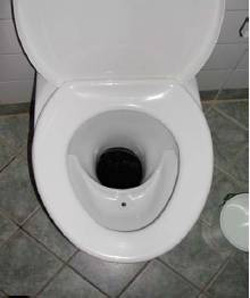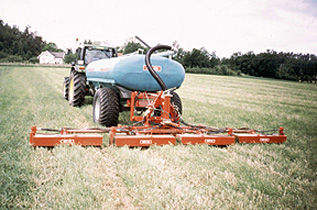
Urine: Waste or fertilizer?
 While
most homesteaders know all about the potential of humanure, I've
seldom heard talk of using urine. After reading Liquid Gold,
I was much more surprised by that oversight since urine has a far lower
potential for creating
health problems and contains a higher percentage of plant
nutrients than the solid portions of humanure.
While
most homesteaders know all about the potential of humanure, I've
seldom heard talk of using urine. After reading Liquid Gold,
I was much more surprised by that oversight since urine has a far lower
potential for creating
health problems and contains a higher percentage of plant
nutrients than the solid portions of humanure.
I'll write in more depth
about the safety issue in later posts,
but it's worth running through a quick overview right off the
bat. Unless you have a urinary tract
or kidney infection (or live in a tropical climate), urine is nearly
always sterile. That means you can use fresh urine around food plants
with very few concerns about food-borne illnesses. Contrast that
with composted
fecal matter, which most humanure advocates recommend using only around
the base of fruit trees or ornamental plants. Why not start your
humanure journey by
just using urine and delete the worry?
Unfortunately, in
traditional western culture, urine is channeled into
the waste stream along with solid human wastes. The additional
volume of waste means that we spend more money and resources treating
our wastewater...and that treatment does nearly no good to the
urine. After treatment, we release the whole shebang into natural
rivers and streams, where the high nitrogen from the urine (not
removed by our conventional treatment processes) causes excessive plant
growth, which leads to drastic drops in dissolved oxygen levels and the
resultant death of aquatic animals.
 Swedish
scientists thinks they've found a better way. Separating toilets
(like the one pictured at the top of the page) are becoming common in
Sweden, where a funnel in the front of the toilet diverts the urine
into a separate waste stream for eventual application to fertilize
fields. Studies suggest that one person's pee provides all the
nitrogen needed to grow half or more of that person's food, and we can
ship urine for more than 100 miles to apply it to agricultural fields
before the energy usage matches that used to "treat" urine in a
wastewater treatment plant.
Swedish
scientists thinks they've found a better way. Separating toilets
(like the one pictured at the top of the page) are becoming common in
Sweden, where a funnel in the front of the toilet diverts the urine
into a separate waste stream for eventual application to fertilize
fields. Studies suggest that one person's pee provides all the
nitrogen needed to grow half or more of that person's food, and we can
ship urine for more than 100 miles to apply it to agricultural fields
before the energy usage matches that used to "treat" urine in a
wastewater treatment plant.
Although it would be
great if our municipal wastewater systems followed
Sweden's example, I'm aways more interested in what each of us can
individually do in our own lives. Stay tuned for more home-scale
applications of urine.
| This post is part of our Urine Fertilizer lunchtime series.
Read all of the entries: |
Want more in-depth information? Browse through our books.
Or explore more posts by date or by subject.
About us: Anna Hess and Mark Hamilton spent over a decade living self-sufficiently in the mountains of Virginia before moving north to start over from scratch in the foothills of Ohio. They've experimented with permaculture, no-till gardening, trailersteading, home-based microbusinesses and much more, writing about their adventures in both blogs and books.
Want to be notified when new comments are posted on this page? Click on the RSS button after you add a comment to subscribe to the comment feed, or simply check the box beside "email replies to me" while writing your comment.

Hi, Anna and Mark. I just came across your blog post on urine as fertilizer, and wondered if you have heard of our institute yet: www.richearthinstitute.org. We are in Vermont and are working with local families and area farmers to recycle human urine as fertilizer. Please check out our site if you have a chance and consider mentioning us if you blog about urine again.
I am also wondering about the photo you have on this page of a tank applicator, as I have never seen that shot before. Is it from an actual urine project? If so, could you point me to where I'd find more information about the context.
Thanks very much, Abe Noe-Hays
Abraham --- Thanks for dropping by! Maybe you'd like to write a guest post for us about your research with urine fertilization? We're always happy to share first-hand information with our readers!
The photo came from the Liquid Gold website (click on the image to see the source). There's not much data about it though. They just say: "A tank fertilizer truck trenches urine into the soil for grain crops in Sweden."